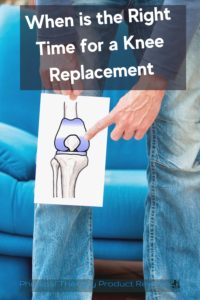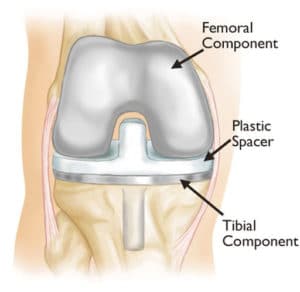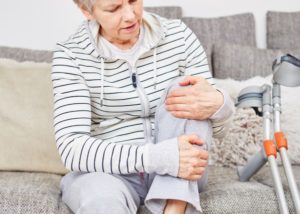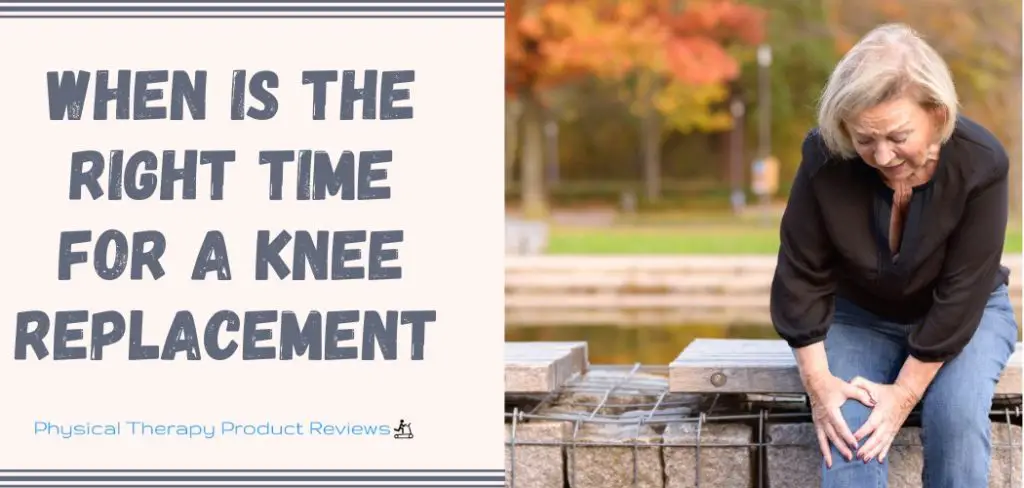Do you long for the days when you woke up bright-eyed and ready for whatever the world threw in your direction? Do your knees creak and pop like the floorboards of an old haunted house when you stand up or walk across the room?
 If you answered yes, you are not alone with this feeling. The feeling of being limited by constant nagging pain. A total knee replacement or TKR as it will be referred to in this article, may be exactly what you need in order to reclaim your life and your independence; when is the right time to get a TKR?
If you answered yes, you are not alone with this feeling. The feeling of being limited by constant nagging pain. A total knee replacement or TKR as it will be referred to in this article, may be exactly what you need in order to reclaim your life and your independence; when is the right time to get a TKR?
The right time for a total knee replacement is when your daily activities have become hindered due to the amount of pain you are experiencing. If you are no longer able to work or participate in the activities that you love, your quality of life suffers and can instigate an entirely different set of problems to deal with.
Life is too short to be in pain. There may be a way to get your life back with little to no pain. Continue reading this guide to help you decide if it is time for you or someone you love to have a total knee replacement. .
What is a Total Knee Replacement?
 A TKR is exactly as it sounds, a total replacement of the knee joint. The degenerative and worn out joint is removed from your body and replaced with artificial components.
A TKR is exactly as it sounds, a total replacement of the knee joint. The degenerative and worn out joint is removed from your body and replaced with artificial components.
Typically a TKR is performed when all other methods of therapy and treatment have been exhausted or when your quality of life is suffering.
When Every Option Has Been Exhausted
A TKR may be necessary when you have tried every alternate method of treatment and therapy.
Common alternatives to surgery are:
- Heat/Ice
- Hydrotherapy
- Steroid Injection Therapy
- Knee Braces
- Oral pain medications
- Physical therapy
- Yoga or stretching
If you have reached the point where you feel as though you have tried every option, then you are a good candidate for a knee replacement.
How is a Total Knee Replacement Performed?
Before you can have your new knee installed it is important that your systems be thoroughly checked for any issues by performing diagnostic testing and pre-surgical bloodwork.
Red-light. Yellow-light. Green-light, GO!
You are all set and have been properly prepped. Now you are laying on your back looking up at a bunch of masked strangers who also happen to be looking back at you.
Start at 100 and count backward the nurse will say. 100, 99, 98…the surgeon(s) will make their incisions, remove the damaged cartilage and bone and replace them with new and improved prosthetics. These artificial joints are typically made from surgical grade metal and plastic.
In this surgery, the orthopedic surgeon with place a metal prosthesis on both the Femur and Tibia, a plastic resurfacing on the backside of the knee cap, and a plastic shock absorber to act as the Meniscus. The surgery is well practiced, guided by tools and imaging, and one of the most common surgeries performed each year.
Some of the latest surgical technology is robot assisted knee replacements. The robot uses 3-D mapping of your knee from the pre-surgery X-rays to guide the incision and placement of the prosthesis to get that perfect fit.
Before you know what happened you will wake up in the recovery room and be another step closer to getting your quality of life back.
Total Knee Replacement Timing: Knowing When to do It
As aforementioned when your quality of life suffers due to the constant, debilitating pain you are ready for a knee replacement. Don’t let pain diminish the quality of your life. Take a stand… literally. Talk to an orthopedic specialist before the damage is irreparable.
Some signs that you might need a knee replacement sooner rather than later:
- You can’t go up and down stairs
- You can longer kneel on the knee to clean under something
- You are having trouble getting in and out of the car because of the loss of motion
- You can no longer bend down to pick something up off the floor
- You are starting to gain weight because of inactivity
- If you are starting to plan your days around your knee pain then it’s time
One side tip: if you wait too long then the muscles of the leg and other parts of the body might loose too much strength from being sedentary
Maintaining Good Knee Health
Think of your body as if it were your vehicle. What happens if you do not properly maintain your ride? You end up walking. In this case, if you don’t properly maintain your ‘ride’ you won’t even be walking; or doing much of anything else for that matter.
For an easy way to exercise with low impact on the knees see our favorite 5 Recumbent bikes after a total knee replacement.
Proper joint health and maintenance is something that most people don’t think much about until they start to get a little older or have experienced a major injury. As with anything, if you take care of it from the beginning, it will last longer and work better.
Ways to prevent and slow joint damage:
- Exercise. Get up and move around. Don’t be like the Tin Man and stiffen up. The less you move, the less you will be able to move. Sometimes it hurts, but avoiding exercise to avoid pain actually has the opposite effect. Try exercises that are low-impact such as water aerobics, yoga or an elliptical machine. Even walking has been proven to be joint protective to help cartilage maintain its stiffness.
- Ladies! Watch the height of those heels. We all know that the higher the heel, the longer the leg looks. Having said that, when you wear heels that are over two inches in height on a regular basis, that puts a lot of strain on your joints. Save those stunners for special occasions and wear a lower heel or flat shoe to prevent premature joint issues.
- Skip those carbs and eat some veggies! We all like our Krispy Kreme donuts as much as the next person, but all those extra carbs put unnecessary weight on your joints. Lowering the weight you carry around will reduce the pressure on your joints. According to a study in Arthritis and Rheumatology, for every 10 pounds of weight you lose, it’s 40 pounds of pressure off of your knees.
- Don’t forget the sun. Vitamin D acts as a catalyst to aid the absorption of calcium. You can also take capsules or a multivitamin with Vitamin D in it. Plus, the more you are outside the more likely you are doing something active and helping your joints.
- Water. Water. Water. Staying hydrated is the essential to staying healthy in general. Drinking water is especially important for joint health because the cartilage in your joints is predominantly made of water.
Think of a sponge and what happens when it has been deprived of water. The same thing happens to your joints when you are dehydrated. Water is basically the ‘oil’ that keeps your joints lubricated and moving.
Another reason to eat healthier is that certain foods can reduce inflammation in your joints. Some of those foods include:
- Avocados
- Berries that are rich in antioxidants
- Dark-green leafy vegetables
- Extra virgin olive oil
- Garlic and onions
- Grapefruit or anything rich in Vitamin C
- Oily fish
- Turmeric
- Walnuts
Waiting Too Long May Lengthen Recovery Time
If you are like many people, you probably try to “suck-it-up” and deal with the pain everyday. In your mind you may think that you are being strong by waiting as long as possible to have your TKR; but in reality, you are actually causing further damage to your joints and trying to deal with the pain.
Don’t be a hero. Get help before it’s too late.
If you suffer from joint pain in your knees then you already know that the pain is not exclusive to your knees. It affects your entire body. The action of “favoring” one side over the other when walking or performing your daily activities puts stress on other parts of your body.

If you are in pain you are also less likely to be moving around like you normally would. Being sedentary can cause your muscles to become weak and atrophy, which will greatly increase your recovery time post-surgery.
Timing is Essential When Planning for Surgery
Correct timing is essential when planning for your surgery. Having a plan will make things go more smoothly. Proper post-operative care is essential to a quick and successful recovery. It is also important to take into account where you are in your personal life.
Plan Around Work
If you are currently working you need to consider that you will need to take roughly 6-8 weeks off before you will even be able to consider going back. This can affect you financially, so be sure that you have enough money saved up to cover your expenses or have supplemental insurance to cover things while you are out of work.
Wait for Help to Be Available
You will need a little extra support for the next several weeks. Be sure that your loved ones are able to work their schedules around to be able to give you the support you need. If you are in a situation where you do not have a support system of family or friends, make arrangements with a home health caregiver and/or a therapist to come and help you after your surgery. You may feel like you may not need help however driving to appointments, laundry, grocery shopping, cooking, and helping with pets can become overwhelming.
Play the Insurance Game
Insurance tends to reset each year at the beginning of January with a select few resetting December 1st and even on July 1st. The absolute best financial time would be to have your knee replacement at the beginning of you insurance year. Yes, you will meet your deductible but the rest of the year everything will be covered in full by insurance. This includes:
- Follow up surgical visits
- Follow up imaging
- Entire physical therapy care
- Any future medical expenses for that year
Typical Recovery Time for a Knee Replacement
Recovery times can vary for each individual due to the following factors:
- Age
- How strong your muscles are
- If you are a smoker your healing time will increase significantly.
- Overall health
- Pre-existing conditions
- The strength and condition of your other joints
Smoking decreases the oxygen levels in your blood and tissues which slows healing time.
Nearly everyone is able to stand and walk within 4-8 hours and go home within one to three days if everything is going favorably.
Yes, you will be up and walking the same day as your surgery!
Sometimes supportive home care and therapy is needed until you are able to get around regularly on your own. If everything is going as it should you will be well on your way to recovery within 6-8 weeks.
As a reminder, you might feel pretty good by 3-6 months after surgery. However, it will take a full year for you to feel “Normal.”
How Long Will A Total Knee Replacement Last?
In many cases a TKR can last as long as 20-25 years or more. The success and lifespan of your replaced knee joint can depend:
- Genetics and pre-existing conditions can affect how quickly you heal.
- How well you follow post-op instructions and physical therapy exercise regimens.
- Living a healthy lifestyle.
Want to make your knee replacement last longer? It’s no different than normal recommendations for knee health. Maintain a healthy weight, exercise 3-4x a week, and quitting smoking will make your knee replacement last to it’s full potential.
In the End it is Your Quality of Life that Matters
Keeping your quality of life in mind will lead you to the right time. When you start to think that you can tough-it out, think of the experiences you will be missing if you put your health on the back burner. Don’t let life pass you by because you didn’t get the help you needed.
Sources:
(https://www.medicalnewstoday.com/articles/247500#preparing_for_surgery)
(https://www.fishertitus.org/health/superfoods-for-healthy-joints)
Other Helpful Rehab Related Articles
How to Stay Active After Cervical Fractures: Expert Tips and Advice
Dealing with Painful Stairs After Ankle Replacement Surgery
Walking After a Total Ankle Replacement: Tips for a Successful Recovery
Exercises While Non-Weight Bearing After Ankle Replacement: Elevation, AROM, Leg Raises, and More
Ankle Pain with Stairs: Causes and Home Treatment Options
5 Common Mistakes You’re Making After an Ankle Sprain
Disclaimer: The information provided in this post is for educational purposes only. This is not a substitute for a medical appointment. Please refer to your physician before starting any exercise program.






